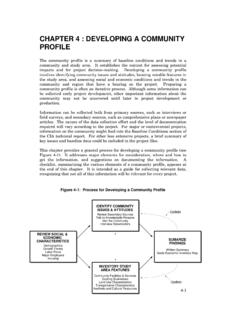Transcription of Developing applications on STM32Cube™ with FatFs
1 February 2019UM1721 Rev 31/27UM1721 User manualDeveloping applications on STM32 Cube with FatFsIntroductionThe STM32 Cube is an STMicroelectronics original initiative to make developers lives easier by reducing development effort, time and cost. STM32 Cube covers the whole STM32 includes: STM32 CubeMX, a graphical software configuration tool that allows the generation of C initialization code using graphical wizards. A comprehensive embedded software platform, delivered per Series (such as STM32 CubeF4 for STM32F4 Series) The STM32 Cube HAL, STM32 abstraction layer embedded software ensuring maximized portability across the STM32 portfolio, A consistent set of middleware components such as RTOS, USB, TCP/IP, Graphics, All embedded software utilities, delivered with a full set of file system is the way in which files ares named and where they are placed logically for storage and retrieval.
2 Its primary objective is to manage access to the data of files, and to manage the available space of the device(s) which contain it. Using a file system allows user to ensure reliability and to organize data in an efficient user manual is intended for developers who use STM32 Cube MCU Package on STM32 microcontrollers. It provides a full description of how to use the STM32 Cube firmware components with a generic FAT file system ( FatFs ); this user manual comes also with description of a set of examples based on common FatFs provided APIs. Please refer to the release notes of the STM32 Cube MCU Package to know the version of FatFs firmware component document is applicable to all STM32 devices; however for simplicity reason, the STM32F4xx devices and STM32 CubeF4 are used as reference platform. To know more about supported physical media disk and the examples implementation on your STM32 device, please refer to the readme file provided within the associated STM32 Cube.
3 Table 1. Application productsTypePart numbers STM32 Cube MCU PackagesSTM32 CubeF0, STM32 CubeF1, STM32 CubeF2, STM32 CubeF3, STM32 CubeF4, STM32 CubeF7, STM32 CubeL0, STM32 CubeL1, STM32 CubeL4, STM32 CubeG0, STM32 CubeH7, Rev 3 Contents1 Acronyms and definitions .. 62 General information .. 73 FAT File System overview .. overview .. Boot Record .. partitions .. license .. 94 FatFs File System .. overview .. architecture .. license .. features .. file access .. file name .. APIs .. low level APIs .. into STM32 CubeF4 .. () .. () .. () .. your own disk to FatFs .. 175 FatFs applications .. drivers configuration .. File System configuration .. file name .. sample application .. 22UM1721 Rev 33/27UM1721 Contents36 Conclusions .. 247 FAQ .. 258 Revision history.
4 26 List of tablesUM17214/27UM1721 Rev 3 List of tablesTable products .. 1 Table and definitions .. 6 Table 3."Diskio_drv_TypeDef" structure .. 15 Table 4."Disk_drv_TypeDef" structure.. 15 Table of FatFs middleware utilization .. 20 Table revision history .. 26UM1721 Rev 35/27UM1721 List of figures5 List of figuresFigure level view of an MBR .. 8 Figure FAT partitions on a device .. 9 Figure architecture .. 11 Figure license .. 12 Figure Middleware module architecture.. 15 Acronyms and definitionsUM17216/27UM1721 Rev 31 Acronyms and definitions Table 2. Acronyms and definitionsAcronymDefinitionANSIA merican national standards instituteAPIA pplication programming interfaceBPBBIOS parameter blockBSPB oard support packageCPUC entral Processing UnitCMSISC ortex microcontroller software interface standard DBCSD ouble byte char stringDOSDisk operating systemEFIE xtensible firmware interfaceFATFile allocation tableHALH ardware abstraction layerLFNLong file nameMBRM aster boot recordMSDM icro secure digitalOEMO riginal equipment manufacturerRAMR andom access memoryRTCReal-time clockRTOSReal-time operating systemSDSecure digitalSDRAMS ynchronous dynamic random access memorySFNS hort file nameSRAMS tatic random access memoryUSBU niversal serial busUM1721 Rev 37/27UM1721 General information262 General informationSTM32 Cube FatFs middleware runs on STM32 32-bit
5 Microcontrollers based on the Arm (1) Cortex -M Arm is a registered trademark of Arm Limited (or its subsidiaries) in the US and or File system overviewUM17218/27UM1721 Rev 33 FAT File system FAT overviewThe File allocation table (FAT) file system was developed by Bill Gates and Marc McDonald. It is a format and some software which stores and organizes files on a storage device, such as a disk drive or a memory device. It is used to facilitate access to files and FAT file system provides a way to time stamp when a file is created or changed and provides a way to identify the size of the file. This system provides a mechanism to store other attributes of a file, such as whether a file is read-only, whether the file should be hidden in a directory display, or whether a file should be archived at the next disk FAT file system is ideal for removable Flash media used in consumer electronic devices, such as digital cameras, media players and Flash FAT file system can be helpful in the following scenarios: Due to the backward compatibility of the FAT file system, users can employ memory stick media or floppy disks to transfer files between a consumer electronic device and a computer that uses an outdated operating system; The FAT file system lets users quickly remove files from electronic devices, as in professional broadcast media.
6 The file system versions, FAT16 or FAT32, may be suitable for a hard disk drive versions would also be useful to a user who wants to boot a computer by using a floppy disk to access data (typically, system recovery tools) on a hard disk drive Master boot recordThe Master boot record (MBR) is located on one or more sectors at the physical start of the device. The boot region of the MBR contains DOS boot loader code , which is written when the device is formatted (but is not otherwise used by the Dynamic C FAT file system). The partition table follows the boot region. It contains four 16-byte entries, which allow up to four partitions on the device. Partition table entries contain some critical information: the partition type (Dynamic C FAT recognizes FAT12 and FAT16 partition types) and the partition's starting and ending sector numbers.
7 There is also a field denoting the total number of sectors in the partition. If this number is zero, the corresponding partition is empty and 1. High level view of an MBR Z W W W W ^ d d d d d & d D Z D Z LJW d UM1721 Rev 39/27UM1721 FAT File system overview26 Some devices are formatted without an MBR and, therefore, have no partition table. This configuration is not currently supported in the Dynamic C FAT file FAT partitionsThe first sector of a valid FAT file system partition contains the BIOS Parameter Block (BPB), followed by the File Allocation Table (FAT), and then the Root Directory. The figure below shows a device with two FAT 2. Two FAT partitions on a deviceBIOS Parameter BlockThe fields of the BPB contain information describing the partition: The number of bytes per sector; The number of sectors per cluster; The total count of sectors on the partition; The number of root directory Allocation TableThe file allocation table is the structure that gives the FAT file system its name.
8 The FAT stores information about cluster assignments. A cluster is either assigned to a file, is available for use, or is marked as bad. A second copy of the FAT immediately follows the first directoryThe root directory has a predefined location and size. It has 512 entries of 32 bytes each. An entry in the root directory is either empty or contains a file or subdirectory name (in format), file size, date and time of last revision and the starting cluster number for the file or areaThe data area takes up most of the partition. It contains file data and subdirectories. Note that the data area of a partition must, by convention, start at cluster more details, refer to the Microsoft EFI FAT32 File System FAT licenseThe Microsoft Extensible Firmware Initiative FAT32 File System Specification, rev. , December 6, 2000, is available as an Office Word document (268 Kbytes).
9 D Z W & d ZKKd^ W W & d ZKKd W & ^ W ^ & ^ W ^ FAT File system overviewUM172110/27UM1721 Rev 3 The download license agreement allows using the Microsoft EFI FAT32 File System Specification only in connection with a firmware implementation of the Extensible Firmware Initiative Specification, v. If you plan to implement the FAT32 File System specification for other purposes, you must obtain an additional license from example, you must obtain an additional license in order to create a file system for reading, or reading and writing FAT32 in digital cameras recording to Flash media, in computer operating systems reading and writing internal/external hard disks or Flash media, or in set-top boxes reading FAT-formatted more details about FAT and applicable licenses and/or copyrights, refer to Microsoft web Rev 311/27UM1721 FatFs File System264 FatFs File FatFs overviewFatFs is a generic FAT file system module for small embedded systems.
10 The FatFs is written in compliance with ANSI C and completely separated from the disk I/O layer. Therefore it is independent of hardware architecture, and has the following features: Windows compatible FAT file system. Very small footprint for code and work area. Various configuration options: Multiple volumes (physical drives and partitions). Multiple ANSI/OEM code pages including DBCS. Long file name support in ANSI/OEM or Unicode. RTOS support. Multiple sector size support. Read-only, minimized API, I/O buffer. FAT sub-types: FAT12, FAT16 and FAT32. Number of open files: Unlimited, depends on available memory. Number of volumes: Up to 10. File size: Depends on FAT specs. (up to 4G-1 bytes) Volume size: Depends on FAT specs. (up to 2T bytes on 512 bytes/sector) Cluster size: Depends on FAT specs. (up to 64K bytes on 512 bytes/sector) Sector size: Depends on FAT specs.
















